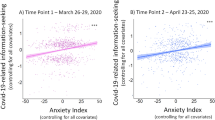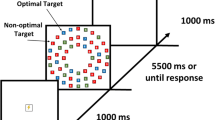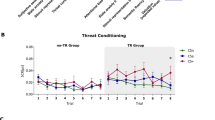Abstract
Beck's (1976) hypothesis that the experience of anxiety is preceded by thoughts with a content of personal threat or danger was evaluated in a study that controlled for effects due to experimenter expectancy. Seventy introductory psychology students were exposed to one of three types of expectancy “training”: One group was trained to expect threat-related thoughts prior to experiencing anxiety, another group was trained to expect loss-related thoughts, and the final group received a neutral training. Subjects were then asked to record their thoughts preceding anxiety experiences in a free-response journal format. Each response was categorized as either a thought of threat, thought of loss, or other thought, and the number of thoughts falling into each category was the dependent variable. Threat was found to be the predominant cognitive content across groups (p < .001), while training had a small but significant (p < .05)effect on subjects' responses. These results are seen as offering qualified support to Beck's proposed threat-anxiety connection.
Similar content being viewed by others
References
Arnold, M. B. (1960).Emotion and personality (Vol. 1). New York: Columbia University Press.
Beck, A. T. (1963). Thinking and depression.Archives of General Psychiatry, 9 324–333.
Beck, A. T. (1970). Role of fantasies in paychotherapy and psychopathology.Journal of Nervous and Mental Disease, 150 3–17.
Beck, A. T. (1972). Cognition, anxiety, and psychophysiological disorders. In C. Spielberger (Ed.),Anxiety: Current trends in theory and research. New York: Academic Press.
Beck, A. T. (1976).Cognitive therapy and the emotional disorders. New York: International Universities Press.
Beck, A. T., Laude, R., & Bonnert, M. (1974). Ideational components of anxiety neurosis.Archives of General Psychiatry, 31 319–325.
Borkovec, T. D., & Nau, S. D. (1972). Credibility of analogue therapy rationales.Journal of Behavior Therapy and Experimental Psychiatry, 3, 257–260.
Coyne, J. C., & Lazarus, R. S. (1980). Cognitive style, stress perception, and coping. In I. L. Kutash, L. B. Schlesinger, & associates (Eds.),Handbook on stress and anxiety. San Francisco: Jossey-Bass.
Dodge, R. (1912). The theory and limitations of introspection.American Journal of Psychology, 23 214–229.
Ellis, A. (1962).Reason and emotion in psychotherapy. New York: Lyle Stuart.
Hurlbert, R. T., & Sipprelle, C. N. (1978). Random sampling of cognitions in alleviating anxiety attacks.Cognitive Therapy and Research, 2, 165–169.
Izard, C. E. (1977).Human emotions. New York: Plenum Press.
Kendall, P. C., & Hollon, S. D. (1981). Assessing self-referent speech: Methods in the measurement of self-statements. In P. C. Kendall & S. D. Hollen (Eds.),Assessment strategies for cognitive-behavioral interventions. New York: Academic Press.
LaPointe, K. A., & Harrell, T. H. (1978). Thoughts and feelings: Correlational relationships and cross-situational consistency.Cognitive Therapy and Research, 4, 311–322.
Meyers, J. I. (1972).Foundamentals of experimental design (2nd ed.). Boston: Allyn and Bacon.
Schachter, S., & Singer, J. E. (1962). Cognitive, social, and physiological determinants of emotional states.Psychological Review, 69 379–399.
Titchner, E. B. (1973).Lectures on the experimental psychology of the thought processes. New York: Arno Press. (Originally published 1909).
Winer, B. J. (1971).Statistical principles in experimental design. New York: McGraw-Hill.
Author information
Authors and Affiliations
Additional information
This article is based on an M.A. thesis by the first author, who was supported during much of its preparation by U. S. Public Health Service Traineeship 5T01MH08929-12. The authors would like to thank George Allen and Charles Lowe for their helpful comments on the research, and Laurie Heatherington, William Matthews, and Eleanor Wertheim for scoring the free-response data.
Rights and permissions
About this article
Cite this article
Sewitch, T.S., Kirsch, I. The cognitive content of anxiety: Naturalistic evidence for the predominance of threat-related thoughts. Cogn Ther Res 8, 49–58 (1984). https://doi.org/10.1007/BF01315097
Issue Date:
DOI: https://doi.org/10.1007/BF01315097




